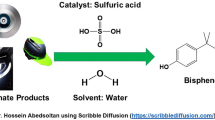Abstract
Chemical recycling of waste poly(carbonate) (PC) to coproduce bisphenol A (BPA) and carbohydrate carbonates was studied by selecting glycerol (Gly) and glucose (Glu) as model carbohydrates (CHs). In advance of the reaction of PC with CHs, reactions with diphenyl carbonate were examined as a model PC. In dioxane at 100°C using NaOH as catalyst, Gly was converted to cyclic carbonate hydroxymethyldioxolane (HMDO) at 98% and Glu was converted to the dicarbonate (Glu-DC) at 46%, in pyridine, in addition to the production of phenol. Similar treatment of PC with Gly using KOH as a catalyst produced HMDO and BPA at very high yields and treatment with Glu produced Glu-DC and BPA in 38%–42% yields.
Similar content being viewed by others
References
Oku A (2006) Chemical recycling of poly(carbonate)s (in Japanese). Plastic Age 52(12):111–116
Hata S, Goto H, Tanaka S, Oku A (2003) Viable utilization of polycarbonate as a phosgene equivalent illustrated by reactions with alkanedithiols, mercaptoethanol, aminoethanethiol, and aminoethanol. J Appl Polym Sci 90:2959
Oku A, Hu L-C, Yamada E (1997) Alkali decomposition of poly(ethylene terephthalate) with sodium hydroxide in nonaqaeous ethylene glycol. J Appl Polym Sci 63:595–601
Hu L-C, Oku A, Yamada E (1998) Alkai-catalyzed methanolysis of polycarbonate. Polymer 39:3841–3845
Oku A, Tanaka S, Hata S (2000) Chemical conversion of poly(carbonate) to bis(hydroxyethyl) ether of bisphenol A. Polymer 41:6749–6753
Hata S, Goto H, Yamada E, Oku A (2002) Chemical conversion of poly(carbonate) to 1,3-dimethyl-2-imidazolidinone (DMI) and bisphenol A. Polymer 43:2109–2116
Katz HE (1987) also reported the preparation and nmr data of HMDO. Macromolecules 20:2026
Komoroski RA, Peat IR, Levy GC (1976) 13C NMR studies of biopolymers. In: George CL (ed) Topics in carbon-13 NMR spectroscopy. Wiley, New York, pp 252–259
The bp was the same to that reported in Beilstein Handbook of Organic Chemistry, Springer, vol. 19,Supplement 4, p 2491
Author information
Authors and Affiliations
Corresponding author
Additional information
Chemical Feedstock Recycling & Other Innovative Recycling Techniques 6
Rights and permissions
About this article
Cite this article
Hidaka, K., Iwakawa, Y., Maoka, T. et al. Viable chemical recycling of poly(carbonate) as a phosgene equivalent illustrated by the coproduction of bisphenol A and carbohydrate carbonates. J Mater Cycles Waste Manag 11, 6–10 (2009). https://doi.org/10.1007/s10163-008-0211-7
Received:
Accepted:
Published:
Issue Date:
DOI: https://doi.org/10.1007/s10163-008-0211-7




